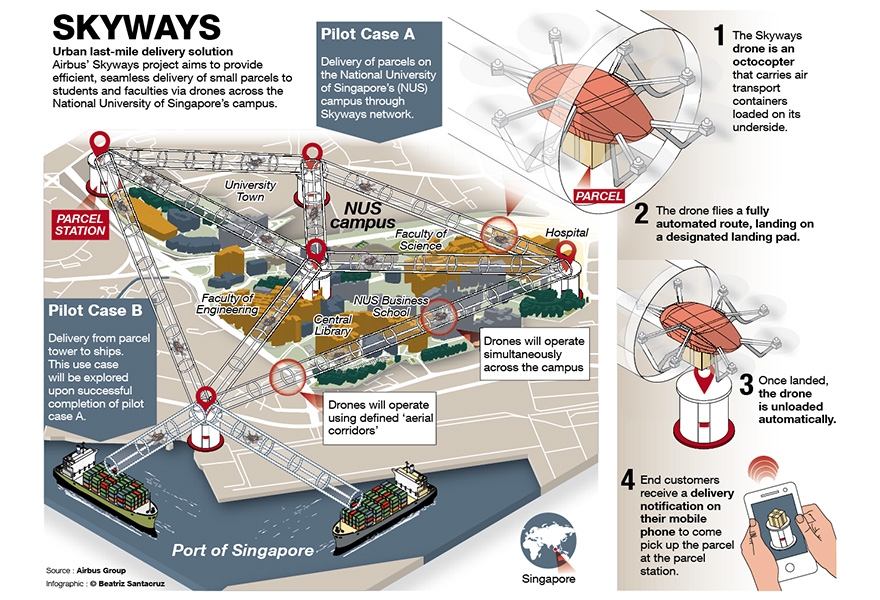Latest News.
Airbus is building a flying, driverless taxi to test in 2017

A team of Airbus engineers based out of Silicon Valley is currently working on the development of a new autonomous flying vehicle platform — one that’s been dubbed “Vahana” by those involved.
The flying-vehicle platform — which is intended to be both used for cargo transport and passenger transport purposes — is slated to begin real-world prototype testing by the end of 2017.

“We believe that global demand for this category of aircraft can support fleets of millions of vehicles worldwide,” stated Rodin Lyasoff, lead Airbus engineer on the project at A3 (the Airbus innovation outpost in Silicon Valley). “In as little as 10 years, we could have products on the market that revolutionize urban travel for millions of people.”

“Many of the technologies needed, such as batteries, motors and avionics are most of the way there,” continued Lyasoff. The project will also require very reliable sense-and-avoid technology, he noted — while such technologies are now being deployed in the automotive sector, no mature solutions are yet available for the aviation sector.
“That’s one of the bigger challenges we aim to resolve as early as possible,” stated Lyasoff.
Airbus is apparently anticipating high demand for Vahana, which would drive associated costs down, making the technology more economical than it may seem at first.
“A3 is powering ahead with Vahana, and as is typical for Silicon Valley, the company thinks in terms of weeks, not years,” an Airbus statement read.
AVweb provides more: “Officially underway since February, the project’s team of internal and external developers and partners has agreed on a vehicle design and are beginning to build and test vehicle subsystems. Meanwhile, developers in France and Germany are working on an electrically operated platform concept for multiple passengers, Airbus said. This aerial vehicle, which goes by the working title of CityAirbus, would have multiple propellers and would resemble a small drone in its basic design. While initially it would be operated by a pilot — similarly to a helicopter — to allow for quick entry into the market, it would switch over to full autonomous operations once regulations are in place, directly benefitting from Vahana’s contribution. The feasibility study has already been completed and the conclusion is favorable, Airbus said.”
The company envisions a scenario where interested customers could simply book a seat on a CityAirbus through a smartphone app, then proceed to the closest helipad and “climb aboard to be whisked away to their destination.”
Courtesy : Clean Technica

Aviation
Nepal Plane Crash: 18 Dead as Aircraft Crashes During Takeoff pilot survives

On July 24, 2024, a tragic accident unfolded at Tribhuvan International Airport in Kathmandu when a Saurya Airlines aircraft crashed during takeoff.
The incident occurred around 11:00 AM local time as the flight, bound for Pokhara, was preparing for departure. The aircraft, carrying 19 individuals including the aircrew, crashed shortly after lifting off the runway. According to PTI, “at least 18 people were killed” in the accident.
The casualties included 18 Nepalis and one Yemeni citizen, all of whom were employees of Saurya Airlines, as confirmed by police. The aircraft was en route for technical maintenance at the time of the crash.
This led in the crash of Yeti Airlines Flight 691, which killed 72 lives:Click here
Images released by Nepal police showed thick smoke pouring from the burning wreckage on the runway. Eyewitnesses, as reported by The Kathmandu Post, described how the plane flipped after its wing-tip struck the ground during takeoff.
The impact led to an immediate fire, and the aircraft subsequently plunged into a gorge on the eastern side of the runway. Rescue operations commenced swiftly, with police and firefighters arriving at the scene to control the situation.
The aviation authority confirmed that rescue efforts were initiated immediately, but the crash underscores the persistent dangers associated with air travel in Nepal. The country’s challenging mountainous terrain often contributes to aviation risks.
Man Falls From Airplane Door In Indonesia After Staff Pull Back Stairs:Click here
The pilot of the aircraft survived the crash and was transported to Kathmandu Medical College Hospital for treatment, as reported by a doctor at the hospital who was not authorized to speak to the media.
In response to the incident, Tribhuvan International Airport, the primary hub for both international and domestic flights in Nepal, was closed as emergency crews worked at the site.
-

 Travel1 week ago
Travel1 week agoAir India to Expand US Operations with Three New Routes After a Decade
-

 Travel2 weeks ago
Travel2 weeks agoWhy We Should Avoid These Stamps in a Passport
-

 Airlines1 month ago
Airlines1 month agoInvestigations Reveal Fake Chinese Titanium in Boeing and Airbus Jets
-

 Tech4 weeks ago
Tech4 weeks agoChina’s CATL Plans 1,800-Mile Electric Plane Launch by 2027
-

 Airport3 days ago
Airport3 days agoTop 10 Largest Airports in the World by Size
-

 Aerospace4 weeks ago
Aerospace4 weeks agoChina’s Fighter Jets Turn Wings into Autonomous Drones
-

 Airlines4 days ago
Airlines4 days agoAir India Rolls Out A350s for Delhi-New York JFK and Newark Routes
-

 Defence3 weeks ago
Defence3 weeks agoBoeing Enhances Chinook with New Engines and Block II Upgrades at $96 Million







